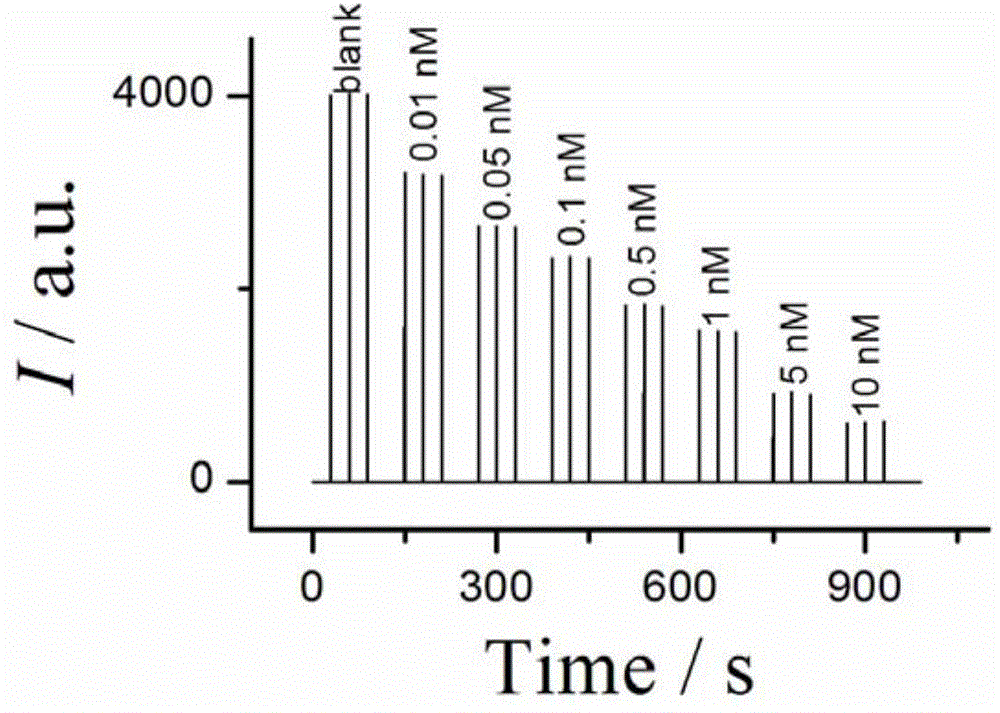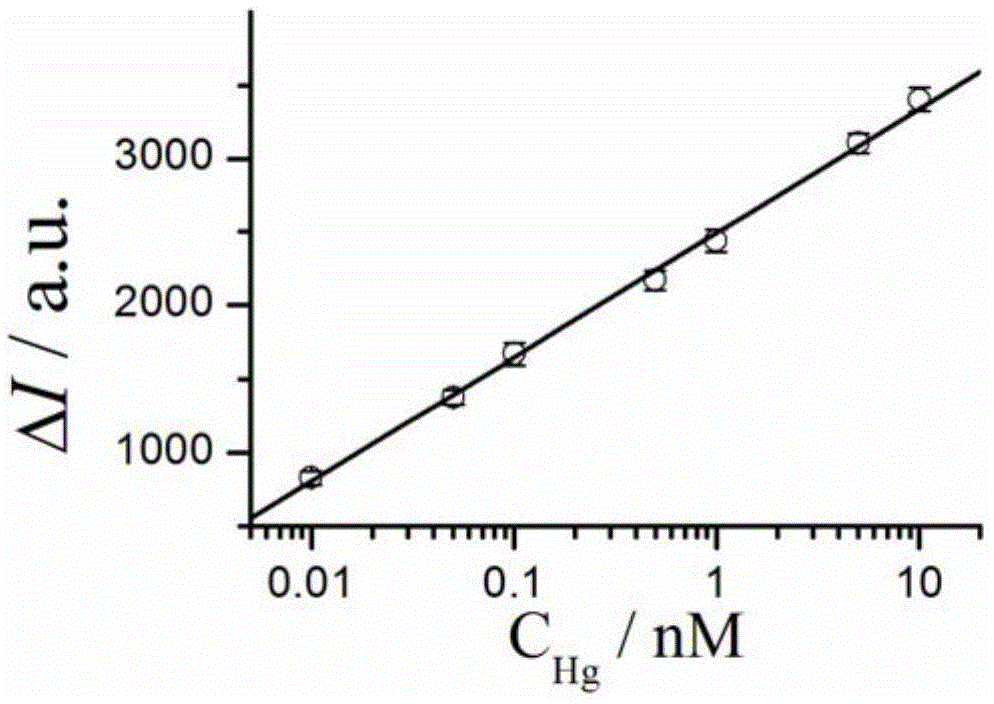Solid electrochemical luminescence sensor for detecting mercury ions and preparation method and application of solid electrochemical luminescence sensor for detecting mercury ions
An electrochemical and mercury ion technology, applied in the field of heavy metal detection, can solve the problems of not being disclosed, and achieve the effect of stable signal, strong selectivity and good reproducibility
- Summary
- Abstract
- Description
- Claims
- Application Information
AI Technical Summary
Problems solved by technology
Method used
Image
Examples
specific Embodiment 1
[0042] A solid-state electrochemical luminescence sensor for detecting mercury ions. The sensor is surface-mounted electropolymerized ABEI, and then sequentially assembled with glutaraldehyde, DNA1, and T-Hg 2+ -T mismatch binding DNA2 and biotin glassy carbon electrode, the specific preparation steps are as follows:
[0043] (1) Preparation of glassy carbon electrode immobilized with DNA1
[0044] a. Glassy carbon electrodes with a diameter of 3-5 mm were polished with 1.0 μm, 0.3 μm, and 0.05 μm Al2O3 in sequence, then ultrasonically cleaned with ethanol and water in sequence, rinsed with water, and dried with nitrogen for later use;
[0045] b. Place the glassy carbon electrode obtained in step (a) in H containing N-(4-aminobutyl)-N-ethylisoluminol (ABEI). 2 SO 4 In the solution, carry out cyclic voltammetry scanning, the voltage range is 0.2 ~ 1.5 V, scan 20 times at a scanning speed of 0.05 V / s, so that ABEI is electropolymerized on the surface of the glassy carbon elec...
specific Embodiment 2
[0062] The method for detecting mercury ions using the solid-state electrochemiluminescence sensor prepared in the above specific embodiment two, the principle of detecting mercury ions is as follows figure 1 As shown, the specific steps are as follows:
[0063] a. After washing the glassy carbon electrode immobilized with DNA1 prepared in the above specific example 2 with 0.01-0.1 M PBS buffer solution, start the process in 0.05-0.2 M carbonate buffer solution with pH = 9-10 Electrochemical reaction, test the intensity of electrochemiluminescence I 0 ;
[0064] b. Put the solid-state electrochemiluminescence sensor for mercury ion detection prepared in the above specific example 2 into 0.05-0.2 M carbonate buffer solution with pH = 9-10, start the electrochemical reaction, and measure the intensity of electrochemiluminescence , to obtain a series of different concentrations of Hg 2+ The corresponding electrochemiluminescence intensity value I of the solution 1 , to calcul...
specific Embodiment 3
[0072] Highly selective and sensitive detection assay
[0073] High sensitivity is embodied by specific embodiment two, because the change value ΔI=I of electrochemiluminescence intensity 0 ?I 1 , has a linear relationship with the logarithm of the concentration of mercury ions in the concentration range of 0.01 to 10 nM. Therefore, the solid-state electrochemiluminescence sensor for detecting mercury ions prepared in the specific embodiment 1 is sensitive to Hg 2+ The detection sensitivity reaches 0.01 nM.
[0074] High selectivity: under the same experimental conditions as in the above-mentioned specific example 2, detect common interfering ions of 10 μM: Pb 2+ , Mn 2+ , Co 2+ , Ni 2+ , Cu 2+ , Zn 2+ , Cd 2+ , Mg 2+ , the result is as Figure 4 shown.
[0075] The results showed: 0.01 nM Hg 2+ The ΔI of the sensor is about 800, while the common interfering ions of 10 μM cause the ΔI of the sensor to be less than 200, which means that 1000000 times of common inter...
PUM
| Property | Measurement | Unit |
|---|---|---|
| diameter | aaaaa | aaaaa |
| recovery rate | aaaaa | aaaaa |
Abstract
Description
Claims
Application Information
 Login to View More
Login to View More - R&D
- Intellectual Property
- Life Sciences
- Materials
- Tech Scout
- Unparalleled Data Quality
- Higher Quality Content
- 60% Fewer Hallucinations
Browse by: Latest US Patents, China's latest patents, Technical Efficacy Thesaurus, Application Domain, Technology Topic, Popular Technical Reports.
© 2025 PatSnap. All rights reserved.Legal|Privacy policy|Modern Slavery Act Transparency Statement|Sitemap|About US| Contact US: help@patsnap.com



